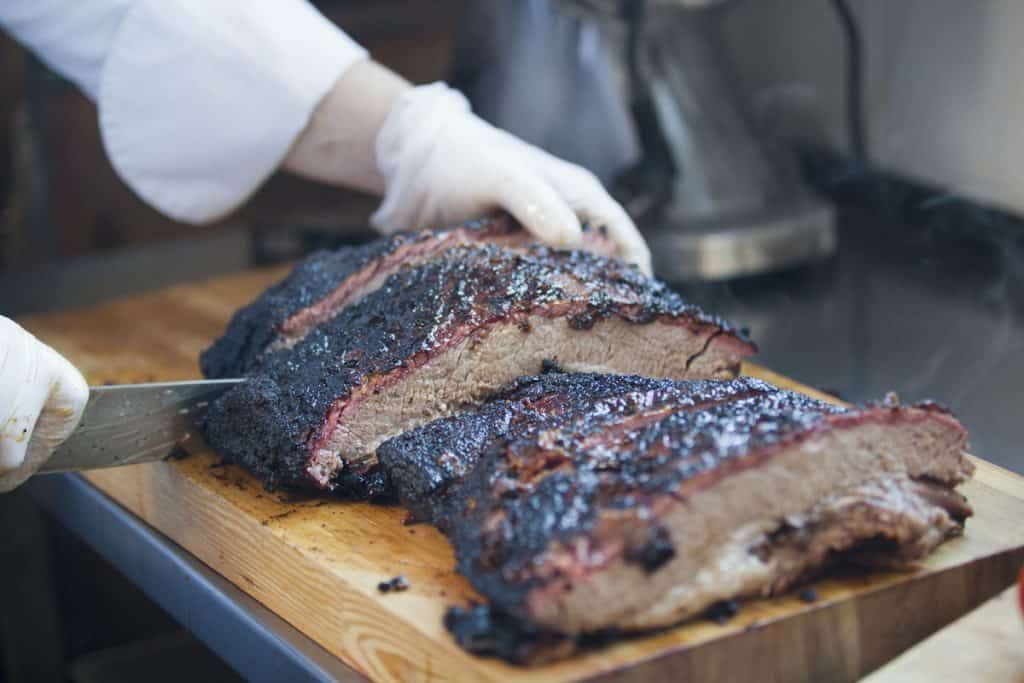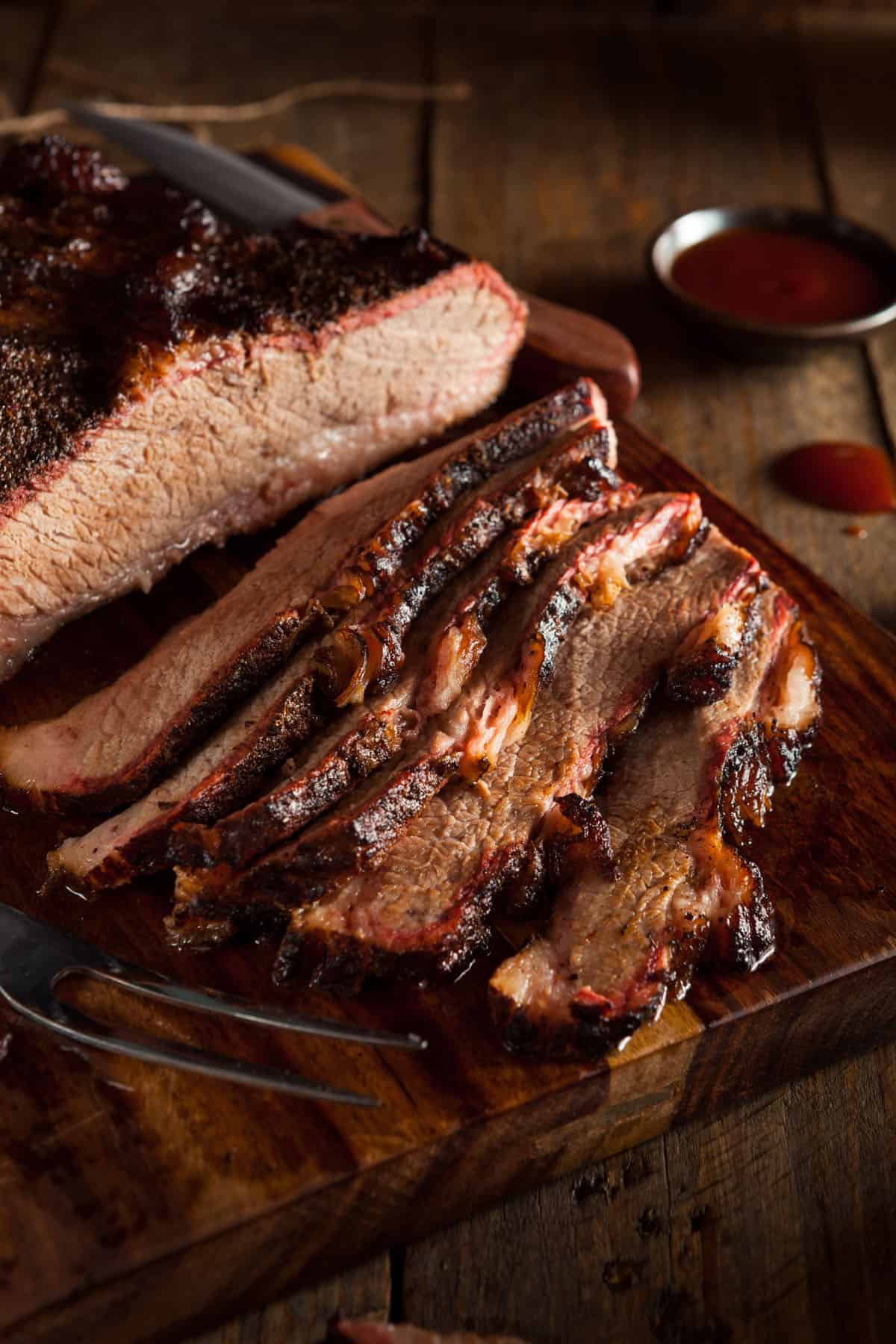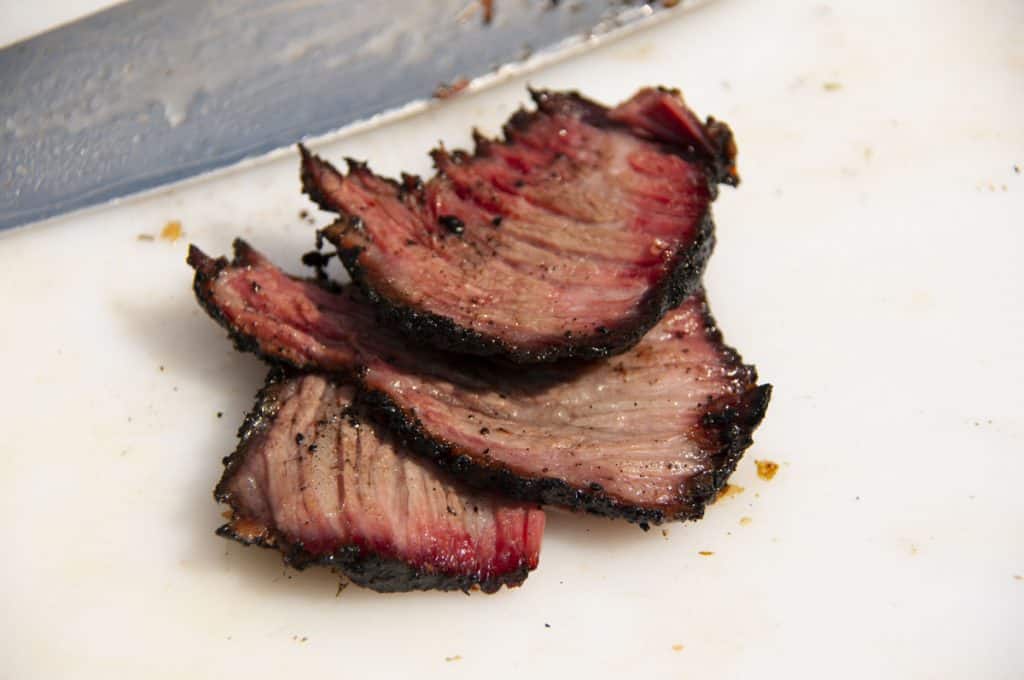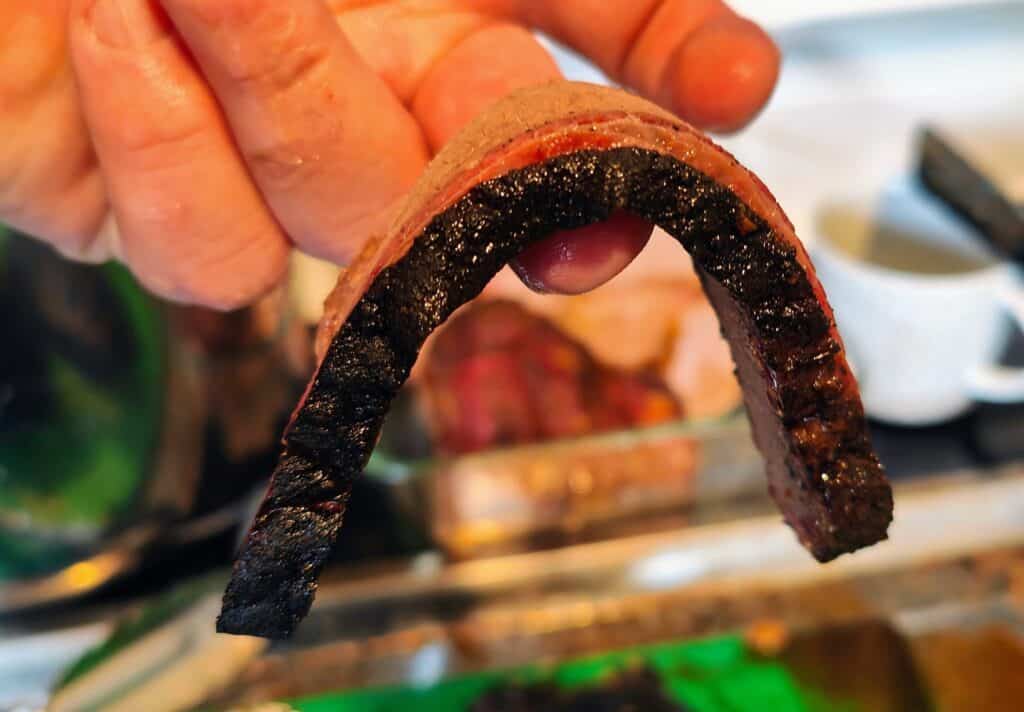Because authentic smoked brisket takes so long to prepare, it can be tempting to dig right in as soon as that beautiful slab of meat comes off the grill. However, as every good pitmaster knows, that would be a grave error. In this guide, we’ll share everything we know about how to rest a brisket so the beef will be juicy and flavorful when it’s finally time to eat.
What Resting Means
The term “resting” refers to the act of allowing meat to sit for a while at room temperature after it’s finished cooking. It’s as simple as that. However, what goes on during the resting period is anything but simple, and it could mean the difference between a fabulous meal and an inedible one.
How To Rest a Brisket
To rest a brisket, first remove it from the heat. If it’s been wrapped in foil or butcher paper, remove the wrapping and place the meat on a platter or cutting board. Leave it alone for at least one hour (see How Long Should You Rest The Brisket?, below), or until you’re ready to serve it.
Why It’s Important

First and foremost, resting the meat gives the juices a chance to redistribute. If you slice right into the brisket after taking it off the heat, those juices will run all over the cutting board instead of staying where they’re supposed to be. That means that when you take that highly anticipated first bite, the meat will be dry and tough.
The second reason is nearly as important as the first. When the meat rests, the temperature will continue to rise 5-10 degrees, so the interior will have that tender texture that you’ve worked so hard to create. This phenomenon is sometimes referred to as “carry-over cooking,” and it makes it easy to overcook your meat if you don’t know what you’re doing.
For optimum results, the brisket’s internal temperature should hit 202 degrees Fahrenheit before serving. That’s why we recommend pulling the brisket out of the smoker when the temp reaches 195 degrees.
How Resting Works
While it’s true that cutting into the brisket too soon will cause the juices to run out, the science behind the phenomenon is slightly more complicated than that.
Raw meat contains a great deal of moisture. In fact, water makes up about three-quarters of the total weight of a raw brisket. The cooking process causes the muscle fibers to contract, thereby forcing moisture toward the center and surface of the beef. This means that lean cuts can be exceptionally dry and tough when cooked to temperatures over 170 degrees, which is recommended for brisket.
Here’s how the resting process helps to combat this issue. Brisket also contains a high amount of collagen, a protein that dissolves during the long cooking process. As the brisket begins to cool, the collagen has a chance to firm up again. It also acts as a thickening agent for the meat’s other natural juices. Therefore, the longer the meat rests, the thicker the liquid will be. This means that the juices won’t be so quick to escape once you’re ready to start slicing.
For the sake of argument, let’s say that you skipped the resting period. Why can’t you just scoop up the drained juices and use those to “baste” the sliced brisket? You can, certainly, but that juice wasn’t the only thing that escaped. When you cut into a piping-hot brisket, you also lose a ton of steam, which can’t be recovered once it’s allowed to evaporate. That’s why you should always allow the brisket to cool to a reasonable temperature before you dig in.

Resting is particularly important for cuts like brisket, which can be unpleasantly chewy when they’re not cooked properly. Also, because the flat contains so much less fat than the point, the meat on that end may be too tough to eat if the steam and juices are permitted to escape.
Just how much moisture will you lose if you opt not to rest the brisket? The answer might surprise you. Experiments have shown that cutting into a large roast immediately after removing it from the heat source will eliminate about 10 tablespoons of liquid. If you wait just 10 minutes, you’ll lose about 4 tablespoons, and waiting 40 minutes will decrease the amount of lost liquid to just under one tablespoon.
One final note: In order to retain any juices that do flow out of the brisket when you start slicing, we would recommend using either a rimmed platter or a cutting board with a built-in groove when it’s time to start slicing.
Resting vs. Holding: Understanding the Difference
If you’ve ever cooked brisket for a crowd, you’re probably familiar with the “faux Cambro” technique. The USDA recommends a minimum temperature of 140 degrees Fahrenheit for keeping cooked meats warm. A Cambro is an insulated box, designed to hold food at this temperature as it’s waiting to be served.
To make a faux Cambro, pitmasters pour a few gallons of hot water into a cooler, close the lid, and allow it to sit for about 30 minutes. When the brisket is finished cooking, they wrap the meat in foil, then set it in an aluminum pan. After carefully dumping out the hot water, they place the wrapped brisket inside the warmed cooler, where it will maintain a safe temperature (without becoming too dry) for up to four hours.
To see the method in action, take a look at this video demonstration.
Some chefs claim that the brisket is at its best when it’s been kept in a Cambro or faux Cambro for two to four hours. Others bemoan the effect that it has on the bark, which won’t be as crisp after essentially steaming in the foil wrapper for all that time. Still, if you have no other option but to cook the brisket ahead of time, this is an effective way to keep the meat warm.
While this is a suitable method for keeping your brisket warm before a large gathering, it doesn’t count as resting. In order to rest properly, the meat needs to be exposed to moving air. This is why you should always remove the wrapping from the brisket before you start the resting period.

How Long Should You Rest the Brisket?
Small cuts of meat, such as pork chops and chicken breasts, will only need to rest for a few minutes. When you’re dealing with a huge chunk of meat like brisket, however, you’ll need to give yourself a lot more time.
If you plan on digging in as soon as possible, it should be allowed to rest for one hour. On the other hand, if you’ve smoked the brisket with the intention of enjoying it at a later date, we would recommend waiting about two hours before shredding or slicing the meat.
If an hour seems like too long to wait, don’t worry. While the meat will cool off enough to allow the collagen to firm up again, it will still be noticeably warm when you serve it.
You can also wait two hours if you’re planning on eating it right away. However, if this is the case, don’t let it rest any longer than that. After the two-hour period is up, the meat will start to cool more rapidly, which means you may need to reheat it. Since reheating will cause the brisket to dry out, you want to avoid this step if possible.
If you want to retain some of the heat while letting the brisket rest for one to two hours, you can tent it loosely with foil. Just make sure that it’s not wrapped too tightly, since exposure to air is a key factor in the resting process.
Tips for Buying Brisket
Brisket is divided into two sections: the point and the flat. The point is fattier, which results in a stronger beef flavor. The flat, meanwhile, is a better choice if you want to carve the meat into thin slices.
For the smoker, we would recommend buying a whole packer brisket. Because they can weigh anywhere from 8 to 20 pounds, they’re a great option when cooking for a large crowd. Even if you’re only cooking for a few people, you can save the leftovers for barbecue beef sandwiches later on.
If you do decide to buy just one half of the brisket, remember to reduce the cooking time accordingly, and keep a close eye on the thermometer to avoid overcooking.
Select beef that’s graded USDA Prime whenever possible. This means that the meat will be high quality, with plenty of marbling to improve the flavor. Additionally, look for meat that’s hormone- and antibiotic-free.
Trimming the Brisket
For best results, trim the brisket while it’s cold. Use a sharp, narrow boning knife to trim the fat cap so only about 1/4-inch remains. Remember that you can leave a bit more fat on the areas that will have the most heat exposure. Also, trim off any bits that are noticeably thinner than the rest–these will overcook and become dry before the rest of the brisket is finished.
Other Tips for Making Brisket
- For a true Texas-style brisket, use equal amounts kosher salt and freshly ground black pepper for the rub.
- Allow the brisket to come to room temperature for about an hour before putting it in the smoker.
- Put the brisket on the smoker with the fat side facing up.
- For best results, smoke the brisket for about 1 hour and 15 minutes per pound.
- Keep a close eye on the thermometer to ensure that the internal temperature of the smoker is holding steady at about 225 degrees Fahrenheit.
- Avoid opening the lid too often, as this will allow heat to escape. If the brisket looks too dry, spritz the exterior with a bit of apple juice, beer, or water.
- When the meat has finished resting, slice it across the grain to ensure maximum tenderness.


Final Thoughts
When it comes to great barbecue, patience is key. Knowing how to rest a brisket correctly will give you amazingly moist and tender meat—the kind that makes you want to fire up the barbecue on a regular basis.
Best of luck, and happy grilling!
Related articles:


Can you elaborate on the resting uncovered? I’ve never heard of it. Every other resource in this subject says to rest wrapped and possibly in a cooler.
While it’s acceptable to use the faux Cambro method when the brisket is done several hours before your planned serving time, doing so will soften the bark. That’s why we recommend resting the meat at room temperature for at least one hour.
You can tent the brisket loosely with foil to help it retain some degree of heat during this time, but wrapping it too tightly will have an adverse effect on the texture. Remember: Your ultimate goal is for the brisket to cool down enough for the juices to redistribute and the collagen to firm up. If the meat continues to steam inside a foil wrapper, that process will be delayed significantly.
I usually wrap my brisket in butcher paper when it reaches the stall (160F) and then let it go until it reaches 203F. Would it be OK to then wrap the brisket (with butcher paper still on) with thick towel (bath towel) and put it in a cooler for a couple of hours?
Or will the temp rise too high like that and make the brisket overcooked?